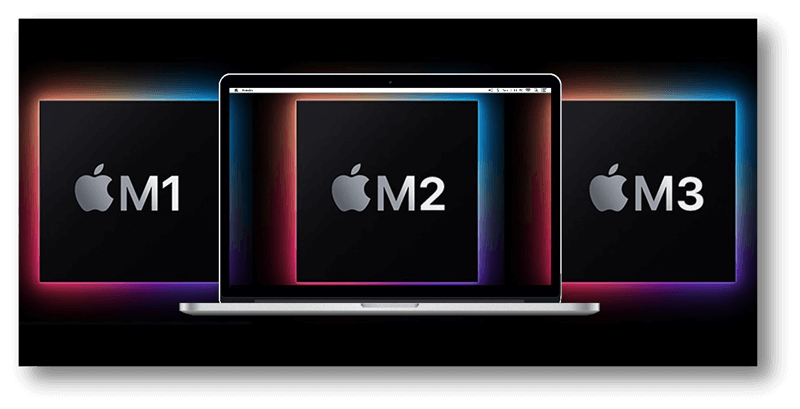In technology, few moves have created as much enthusiasm and anticipation as Apple's transition from Intel-based processors to their in-house Apple silicon chips. The M1 chip was revolutionary, allowing Apple's products to function at a level never before achieved while using far less power.
Following this model's success, Apple developed the M2 chip and is working on the much-anticipated M3 chip. These innovations in silicon design have altered the computer industry, opening the door to faster, more efficient machines with more advanced features. The differences between the M1, M2, and M3 chips are subtle, but let's go into the realm of Apple Silicon and find out what they are.

The M1 Chip: A Game-Changer:
The M1 chip, released in late 2020, was a huge improvement. Fabricated on a 5-nanometer technology, it merged an 8-core CPU, 8-core GPU, and a 16-core Neural Engine into a single chip. Combining these significant features improved the functionality and efficiency of electronic devices. Apple's boasts of desktop-class performance with minimum power consumption were verified by the M1-equipped MacBook Air, MacBook Pro, and Mac Mini, which stunned users with speed and extended battery life.
The M1 introduced a unified memory system and cutting-edge technologies like Firestorm cores for high performance and Icestorm cores for low power consumption. This hybrid layout allowed uninterrupted switching between tasks, improving performance and prolonged battery life.
The M2 Chip: Evolution in Performance:
Apple released the M2 chip, improving the M1's performance and efficiency. Expected upgrades included more cores for the CPU and GPU, faster clock speeds, and more efficient cores that should extend the battery's life.
In addition, there was talk of enhanced machine learning capabilities, with some speculating that the Neural Engine would be upgraded to perform AI and ML tasks more effectively. Faster rendering, less choppy multitasking, and better overall performance were all claims made with the M2.
The M3 Chip: Anticipating the Next Leap:
While Apple has been tight-lipped on the M3 processor, industry speculation and the company's history of innovation point to a significant improvement that might establish new standards. Expected to leverage new manufacturing processes, the M3 might contain more CPU and GPU cores, further refining the Neural Engine and optimizing power efficiency.
The rumor mill has it that the M3 chip, which provides unprecedented performance and sets new benchmarks for portable computing, will be at the heart of the next generation of MacBooks. With Apple's dedication to R&D, we should expect the M3 chip to carry on the tradition of industry-changing innovations in silicon.
Which CPU Is Better, an M3, an M2, or an M1?
Like its forerunners, the M1 and M2 chips, the M3 microprocessor has eight Central Processing Unit (CPU) cores, four dedicated to performance and four to efficiency. That enables effective task management by assigning the performance cores to activities that use many system resources and the efficiency cores to those that don't.
Apple's M3 chip family also includes new high-performance and energy-efficient cores. Apple claims that the M3 chipset's high-performance core is 15% quicker than the high-performance core included in the M2 chipset. And Apple M3's efficiency core is 30% quicker than M2's. However, Apple has rebuilt the CPU cluster and lowered the performance cores in M3 Pro.
The new Apple M3 Pro has a more even distribution of its 6 high-performance and 6-efficiency cores (6P+6E), as opposed to the 8P+4E configuration of the Apple M2 Pro.
Conclusion:
Apple's path with its M-series CPUs stands as a monument to persistent progress in silicon technology. Each new generation of M processors, from the ground-breaking M1 to the highly anticipated M3, promises to fundamentally alter how we think about computing in terms of performance and efficiency.
The IT community eagerly awaits the official presentation of the M3 and its eventual incorporation into Apple's portfolio as Apple's M-series CPUs continue to push the boundaries of what is possible in computing. Apple's dedication to innovation, benchmarking, and encouraging the tech sector to reach new heights is displayed in the progression from M1 to M3. Apple's pioneering role in defining the future of computing is shown by the M1, M2, and the highly anticipated M3 processor.